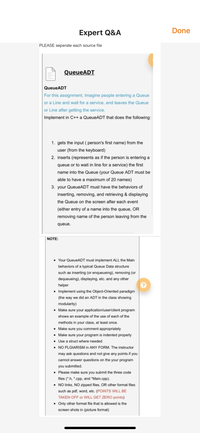
Database System Concepts
7th Edition
ISBN: 9780078022159
Author: Abraham Silberschatz Professor, Henry F. Korth, S. Sudarshan
Publisher: McGraw-Hill Education
expand_more
expand_more
format_list_bulleted
Question
PLEASE SEPARATE EACH SOURCE CODE

Transcribed Image Text:Expert Q&A
Done
PLEASE seperate each source file
QueueADT
QueueADT
For this assignment, Imagine people entering a Queue
or a Line and wait for a service, and leaves the Queue
or Line after getting the service.
Implement in C++ a QueueADT that does the following:
1. gets the input ( person's first name) from the
user (from the keyboard)
2. inserts (represents as if the person is entering a
queue or to wait in line for a service) the first
name into the Queue (your Queue ADT must be
able to have a maximum of 20 names)
3. your QueueADT must have the behaviors of
inserting, removing, and retrieving & displaying
the Queue on the screen after each event
(either entry of a name into the queue, OR
removing name of the person leaving from the
queue.
NOTE:
Your QueueADT must implement ALL the Main
behaviors of a typical Queue Data structure
such as inserting (or enqueueing), removing (or
dequeueing), displaying, etc. and any other
helper
• Implement using the Object-Oriented paradigm
(the way we did an ADT in the class showing
modularity)
• Make sure your application/user/client program
shows an example of the use of each of the
methods in your class, at least once.
• Make sure you con
nent appropriately
• Make sure your program is indented properly
• Use a struct where needed
• NO PLGIARISM in ANY FORM. The instructor
may ask questions and not give any points if you
cannot answer questions on the your program
you submitted.
• Please make sure you submit the three code
files (*.h, *.cpp, and *Main.cpp).
• NO links, NO zipped files, OR other format files
such as pdf, word, etc. (POINTS WILL BE
TAKEN OFF or WILL GET ZERO points)
• Only other format file that is allowed is the
screen shots in (picture format)
Expert Solution
This question has been solved!
Explore an expertly crafted, step-by-step solution for a thorough understanding of key concepts.
This is a popular solution
Trending nowThis is a popular solution!
Step by stepSolved in 3 steps with 4 images

Knowledge Booster
Learn more about
Need a deep-dive on the concept behind this application? Look no further. Learn more about this topic, computer-science and related others by exploring similar questions and additional content below.Similar questions
- 13) BTFSC DATA1,3. BRA LABEL1 RLNCF DATA2,W LABEL2 BRA LABEL1 RRNCF DATA3,W LABEL2 NOP WREGEarrow_forwardHi, I am looking for some help to solve this question. I cannot figure out how to solve it and the code below is all I have. Please be advised I am using PostgreSQL. Thus, I must use LANGUAGE PLPGSLQ as that is what the professor is looking for. Thank you for your help. Code CREATE TABLE instructor_course_nums (ID VARCHAR(25), name VARCHAR(25), tot_courses VARCHAR(25)); CREATE TEMPORARY TABLE instructor_course_nums (ID VARCHAR(5),name VARCHAR(20),tot_courses INTEGER); CREATE OR REPLACE PROCEDURE Moreno_03_insCourseNumsProc(INOUT i_ID VARCHAR(5))LANGUAGE PLPGSQLAS$$arrow_forwardAddress ValidationImagine you get a data set from a client that contains addresses from 150 countries all around the world and your task is to verify it, the data is stored in 3 fields – Address Line, City, and ZIP code. What you also have available is an address verification solution for each country, but the data set does not include the country code. Your task is to design a logic that will process the data and find the related country for each record, so they can be run through the relevant validation component. Think of the most efficient way. Describe your solution proposal ideally in an algorithmic way (e.g. using appropriate UML diagrams, pseudo-code, list of steps…)Hint: Running all of those 150 address verification components against each record is not considered efficientarrow_forward
arrow_back_ios
arrow_forward_ios
Recommended textbooks for you
 Database System ConceptsComputer ScienceISBN:9780078022159Author:Abraham Silberschatz Professor, Henry F. Korth, S. SudarshanPublisher:McGraw-Hill Education
Database System ConceptsComputer ScienceISBN:9780078022159Author:Abraham Silberschatz Professor, Henry F. Korth, S. SudarshanPublisher:McGraw-Hill Education Starting Out with Python (4th Edition)Computer ScienceISBN:9780134444321Author:Tony GaddisPublisher:PEARSON
Starting Out with Python (4th Edition)Computer ScienceISBN:9780134444321Author:Tony GaddisPublisher:PEARSON Digital Fundamentals (11th Edition)Computer ScienceISBN:9780132737968Author:Thomas L. FloydPublisher:PEARSON
Digital Fundamentals (11th Edition)Computer ScienceISBN:9780132737968Author:Thomas L. FloydPublisher:PEARSON C How to Program (8th Edition)Computer ScienceISBN:9780133976892Author:Paul J. Deitel, Harvey DeitelPublisher:PEARSON
C How to Program (8th Edition)Computer ScienceISBN:9780133976892Author:Paul J. Deitel, Harvey DeitelPublisher:PEARSON Database Systems: Design, Implementation, & Manag...Computer ScienceISBN:9781337627900Author:Carlos Coronel, Steven MorrisPublisher:Cengage Learning
Database Systems: Design, Implementation, & Manag...Computer ScienceISBN:9781337627900Author:Carlos Coronel, Steven MorrisPublisher:Cengage Learning Programmable Logic ControllersComputer ScienceISBN:9780073373843Author:Frank D. PetruzellaPublisher:McGraw-Hill Education
Programmable Logic ControllersComputer ScienceISBN:9780073373843Author:Frank D. PetruzellaPublisher:McGraw-Hill Education

Database System Concepts
Computer Science
ISBN:9780078022159
Author:Abraham Silberschatz Professor, Henry F. Korth, S. Sudarshan
Publisher:McGraw-Hill Education

Starting Out with Python (4th Edition)
Computer Science
ISBN:9780134444321
Author:Tony Gaddis
Publisher:PEARSON

Digital Fundamentals (11th Edition)
Computer Science
ISBN:9780132737968
Author:Thomas L. Floyd
Publisher:PEARSON

C How to Program (8th Edition)
Computer Science
ISBN:9780133976892
Author:Paul J. Deitel, Harvey Deitel
Publisher:PEARSON

Database Systems: Design, Implementation, & Manag...
Computer Science
ISBN:9781337627900
Author:Carlos Coronel, Steven Morris
Publisher:Cengage Learning

Programmable Logic Controllers
Computer Science
ISBN:9780073373843
Author:Frank D. Petruzella
Publisher:McGraw-Hill Education